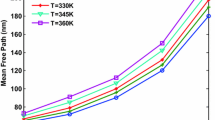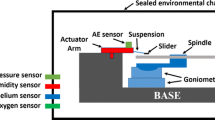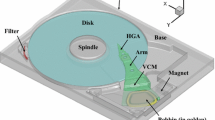Abstract
Helium-filled drives have recently been commercialized to enable a high recording density. However, because the use of helium increases production costs, binary gas mixtures such as air–helium have been investigated. In this paper, the dominant performance metrics of hard disk drives (HDDs) are the windage losses, the flow induced vibration (FIV), the lubricant transfer and lubricant depletion. These were investigated for air–helium gas mixtures as a function of the helium fraction. The frictional torque was empirically derived in both the laminar and turbulent regimes. The windage loss and the FIV of a helium-filled drive were found to be similar to that using an air–helium gas mixture with a helium fraction of 0.75. On the other hand, the quantity of accumulated lubricant and the maximum lubricant depletion in a helium fraction of 0.75 were superior to those in a helium fraction of 1.0. Further investigation of performance metrics should be carried out. However the performance metrics considered here showed that a helium fraction of 0.75 was favorable to a helium fraction of 1.0.







Similar content being viewed by others
References
Bird GA (1994) Molecular gas dynamics and the direct simulation of gas flow. Oxford University Press, New York
Bruno M, Tom K, Qing D, Remmelt P (2003) A model for lubricant flow from disk to slider. IEEE Trans Magn 39:2447–2449
Choi J, Park K, Park N, Park Y (2015) Flying stability of a slider with a damaged diamond like carbon layer induced by confined optical energy in a thermally assisted magnetic recording system. In: MIPE2015 conference proceeding
Coughlin Tm (2015) New digital storage solutions enable growing consumer applications. IEEE Consum Electron Mag 4:107–109
Hermann S (1979) Boundary-layer theory. McGraw-Hill, New York
Jiaping Y, Cheng P, Eng H (2010) Thermal analysis of helium-filled enterprise disk drive. Microsyst Technol 16:1699–1704
Keiji A, Masaya S, Keishi S, Toru W (2007) A study on positioning error caused by flow induced vibration using helium-filled hard disk drives. IEEE Trans Magn 43:3750–3755
Kyo A, Kazuaki U (2009) Written-in RRO and NRRO characteristics in mobile hard disk drives. IEEE Trans Magn 45:5112–5117
Lin W (2006) Modeling and simulation of the interaction between lubricant droplets on the slider surface and air flow within the head/disk interface of disk drives. IEEE Trans Magn 42:2480–2482
Ma Y, Liu B (2007) Lubricant transfer from disk to slider in hard disk drives. Appl Phys Lett 90:143516
Ma Y, Liu B (2008) Dominant factors in lubricant transfer and accumulation in slider-disk interface. Tribol Lett 29:119–127
Nan L, Jinglin Z, David B (2011) Thermal flying-height control sliders in air–helium gas mixtures. IEEE Trans Magn 47:100–104
Park K (2015) Analysis of accumulated lubricant for air–helium gas mixture in HDDs. In: MIPE2015 conference proceeding
Park K-S, Choi J, Park NC, Park YP (2013a) Effect of temperature and helium ratio for performance of thermal flying control in air–helium gas mixture. Microsyst Technol 19:1679–1684
Park K, Choi J, Park Y, Park N (2013b) Thermal deformation of thermally assisted magnetic recording head in binary gas mixture at various temperatures. IEEE Trans Magn 49:2671–2676
Poling BE, Prausnitz JM, O’Connell J (2001) The properties of gases and liquids, 5th edn. McGraw-Hill, New York
Remmelt P, Bruno M, Steve M, Vamsi V (2001) Formation of lubricant “moguls” at the head/disk interface. Tribol Lett 10:133–142
Rohit P, David B (2006) Lubricant depletion and disk-to-head lubricant transfer at the head-disk interface in hard disk drives. In: STLE/ASME 2006 international joint tribology conference, pp 1519–1526
Rohit P, David B, Qing D, Bruno M (2008) Critical clearance and lubricant instability at the head-disk interface of a disk drive. Appl Phys Lett 92:033104
Yamaguchi Y, Takahashi K, Fujita H (1986) Flow induced vibration of magnetic head suspension in hard disk drive. IEEE Trans Magn 5:1022–1024
Zhang Q, Sundaravadivelu K, Liu N, Jiang Q (2015) Method of quick prediction of windage power loss. In: MIPE2015 conference proceeding
Acknowledgments
This research was supported by Basic Science Research Program through the National Research Foundation of Korea (NRF) funded by the Ministry of Science, ICT & Future Planning (2015037574).
Author information
Authors and Affiliations
Corresponding author
Rights and permissions
About this article
Cite this article
Park, KS. The optimal helium fraction for air–helium gas mixture HDDs. Microsyst Technol 22, 1307–1314 (2016). https://doi.org/10.1007/s00542-015-2698-x
Received:
Accepted:
Published:
Issue Date:
DOI: https://doi.org/10.1007/s00542-015-2698-x




